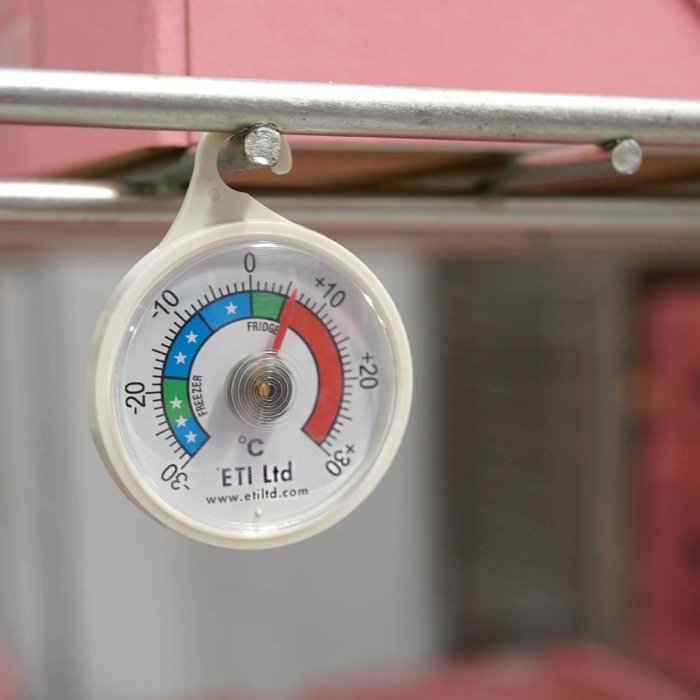The Importance of Fridge & Freezer Thermometers for Food Safety and Efficiency
Maintaining the right temperature in your fridge and freezer is crucial for food safety, preserving freshness, and ensuring your appliances run efficiently. While most fridges and freezers have built-in temperature controls, these aren’t always accurate. That’s where a dedicated fridge and freezer thermometer comes in. This simple, yet essential tool helps monitor and maintain the optimal temperature range for food safety and storage. In this blog, we’ll explore the benefits of fridge and freezer thermometers, how to use them, and why they’re a must-have for any kitchen.
Why Use a Fridge and Freezer Thermometer?
1. Ensure Food Safety
The primary reason to use a thermometer in your fridge or freezer is to keep food at safe temperatures. The U.S. Food and Drug Administration (FDA) recommends keeping your fridge at 40°F (4°C) or lower, and your freezer at 0°F (-18°C) to prevent bacterial growth and food spoilage. A thermometer helps you monitor these temperatures accurately, reducing the risk of foodborne illnesses.
2. Prevent Food Waste
Improper temperatures can cause food to spoil faster or freeze unevenly, leading to waste. With a fridge or freezer thermometer, you can ensure your appliances are operating at the right temperatures, helping your food stay fresh longer. This not only reduces waste but also saves you money in the long run by preserving your groceries.
3. Energy Efficiency
A fridge or freezer that’s too warm or too cold can waste energy, leading to higher utility bills. By using a thermometer, you can confirm that your appliance is operating within the correct temperature range, improving energy efficiency and potentially extending the lifespan of your fridge or freezer.
4. Peace of Mind
Knowing your food is stored at the proper temperature gives you peace of mind, especially when you have perishable items like dairy, meat, and frozen foods. Regularly checking the temperature can prevent unexpected surprises, like spoiled food or thawing frozen goods, which can lead to loss and waste.
Types of Fridge and Freezer Thermometers
Fridge and freezer thermometers come in various styles, each with unique features. Here are some of the most common types:
1. Analog Thermometers
Analog thermometers feature a dial or thermometer display with a probe that you place inside the fridge or freezer. These are straightforward and don’t require batteries, but they may not be as precise or easy to read as digital models.
2. Digital Thermometers
Digital fridge and freezer thermometers offer precise, easy-to-read temperature readings on an LCD screen. Some models even come with a probe that you can place in the fridge or freezer, while others feature wireless sensors that allow you to monitor the temperature remotely.
3. Wireless Thermometers
Wireless thermometers connect to your smartphone or a remote monitoring system, allowing you to track the temperature of your fridge and freezer without having to open the door. This can be particularly useful for those who have multiple fridges or freezers in their home or business.
4. Maximum/Minimum Thermometers
These thermometers keep track of the highest and lowest temperatures reached in your fridge or freezer. This feature is useful for monitoring temperature fluctuations, especially in cases where the appliance door is opened frequently or during power outages.
How to Use a Fridge and Freezer Thermometer
Using a fridge and freezer thermometer is simple, but proper placement and regular checks are important for accurate readings:
- Place the Thermometer Correctly
- In your fridge, place the thermometer in the center, ideally on the middle shelf. Avoid putting it near the door, as temperatures tend to fluctuate there.
- In your freezer, place the thermometer in the middle of the compartment, away from the walls and door. This will give you the most consistent reading.
- Check Regularly
- For best results, check the thermometer at least once a week. If you notice that the temperature is too high or too low, adjust your fridge or freezer settings accordingly.
- Use the Right Temperature Range
- Set your fridge to 40°F (4°C) or lower.
- Set your freezer to 0°F (-18°C) for optimal food storage.
- Calibrate if Needed
- Some thermometers may need occasional calibration to ensure accurate readings. Always follow the manufacturer’s instructions for calibration.

Benefits of Investing in a Fridge and Freezer Thermometer
1. Prevents Foodborne Illness
Keeping your food at the correct temperature prevents the growth of harmful bacteria, like Salmonella and E. coli, which can thrive at improper temperatures.
2. Saves Money
A well-maintained fridge and freezer run more efficiently, consuming less energy. Additionally, knowing the right temperature can help avoid spoilage and waste, saving you money on groceries.
3. Longer Appliance Life
By ensuring your fridge or freezer is operating correctly, you help prevent wear and tear on the appliance, which could lead to costly repairs or replacements.
4. Easy to Use
Fridge and freezer thermometers are user-friendly, even for beginners. Whether you choose a simple analog model or a high-tech digital thermometer, these devices are quick to set up and easy to maintain.
Conclusion
A fridge and freezer thermometer is an essential tool for every kitchen. By ensuring your appliances maintain the correct temperature, you protect your food, save money, and increase energy efficiency. Whether you prefer a simple analog thermometer or a high-tech digital model, adding a thermometer to your fridge or freezer will provide you with greater control over food safety and help prevent spoilage or waste.
Invest in a fridge and freezer thermometer today for peace of mind, better food preservation, and improved kitchen efficiency.
